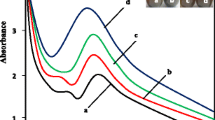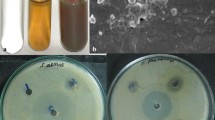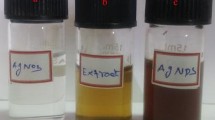Abstract
The green synthesis of silver nanoparticles represents an important strategy for production of alternative antibacterial agents. Herein, the reduction of silver nanoparticles is provided by the action of leaf extract of Ziziphus joazeiro. The as-synthesized material presented pH-dependent behavior that affects the kinetics of nanoparticles nucleation and the following aggregation. Alkaline and acidic environment favors the increasing polydispersity of nanoparticles providing the production of different distribution of particle size. At neutral condition (pH 7), particles with lower size and reduced aggregation degree are obtained and present antibacterial activity against S. aureus and E. coli. The number of viable cells for both systems (from initial culture containing 104 colonies) reached negligible counting after 5 h of interaction with silver nanoparticles prepared at neutral pH.







Similar content being viewed by others
References
Agnihotri S, Mukherji S, Mukherji S (2013) Immobilized silver nanoparticles enhance contact killing and show highest efficacy: elucidation of the mechanism of bactericidal action of silver. Nanoscale 5(16):7328–7340
Alippilakkotte S, Kumar S, Sreejith L (2017) Fabrication of PLA/Ag nanofibers by green synthesis method using Momordica charantia fruit extract for wound dressing applications. Col Surf A 529:771–782
Allahverdiyev AM, Kon KV, Abamor ES, Bagirova M, Rafailovich M (2011) Coping with antibiotic resistance: combining nanoparticles with antibiotics and other antimicrobial agents. Expert Rev Anti Infect Ther 9(11):1035–1052
Andrews D, Nann T, Lipson RH (2019) Comprehensive nanoscience and nanotechnology. Academic Press, Cambridge
Arango-Santander S, Pelaez-Vargas A, Freitas SC, García C (2018) A novel approach to create an antibacterial surface using titanium dioxide and a combination of dip-pen nanolithography and soft lithography. Sci Rep 8(1):15818
Behravan M, Panahi AH, Naghizadeh A, Ziaee M, Mahdavi R, Mirzapour A (2019) Facile green synthesis of silver nanoparticles using Berberis vulgaris leaf and root aqueous extract and its antibacterial activity. Int J Biol Macromolec 124:148–154
Bhutto AA, Kalay Ş, Sherazi S, Culha M (2018) Quantitative structure–activity relationship between antioxidant capacity of phenolic compounds and the plasmonic properties of silver nanoparticles. Talanta 189:174–181
Deshmukh S, Patil S, Mullani S, Delekar S (2019) Silver nanoparticles as an effective disinfectant: a review. Mater Sci Eng 97:954–965
Gavade N, Kadam A, Suwarnkar M, Ghodake V, Garadkar K (2015) Biogenic synthesis of multi-applicative silver nanoparticles by using Ziziphus Jujuba leaf extract. Spectrochim Acta A 136:953–960
Gharibshahi L, Saion E, Gharibshahi E, Shaari A, Matori K (2017) Structural and optical properties of Ag nanoparticles synthesized by thermal treatment method. Materials 10(4):402
Golla N (2018) Phytosynthesis and antimicrobial studies of silver nano particles using Ziziphus nummularia leave extracts. MOJ Drug Des Develop Ther 2(5):4
Halawani EM (2016) Rapid biosynthesis method and characterization of silver nanoparticles using Zizyphus spina christi leaf extract and their antibacterial efficacy in therapeutic application. J Biomater Nanobiotechnol 8(1):22–35
Hassan YI, Lahaye L, Gong MM, Peng J, Gong J, Liu S, Gay CG, Yang C (2018) Innovative drugs, chemicals, and enzymes within the animal production chain. Vet Res 49(71):1–17
Jaybhaye SV (2015) Antimicrobial activity of silver nanoparticles synthesized from waste vegetable fibers. Mater Today 2(9):4323–4327
Khatoon UT, Rao GN, Mohan KM, Ramanaviciene A, Ramanavicius A (2017) Antibacterial and antifungal activity of silver nanospheres synthesized by tri-sodium citrate assisted chemical approach. Vacuum 146:259–265
Lin J, Chen X, Chen C, Hu J, Zhou C, Cai X, Wang W, Zheng C, Zhang P, Cheng J (2018) Durably antibacterial and bacterially antiadhesive cotton fabrics coated by cationic fluorinated polymers. ACS Appl Mater Interf 10(7):6124–6136
Loftus RW, Koff MD, Brown JR, Patel HM, Jensen JT, Reddy S, Ruoff KL, Heard SO, Yeager MP, Dodds TM (2015) The epidemiology of Staphylococcus aureus transmission in the anesthesia work area. Anesth Analg 120(4):807–818
Lv Z, Wang Y, Chen Z, Sun L, Wang J, Chen M, Xu Z, Liao Q, Zhou L, Chen X, Li J, Zhou K, Zhou Y, Zeng YJ, Han ST, Roy VAL (2018a) Phototunable biomemory based on light-mediated charge trap. Adv Sci (Weinh) 5(9):1800714
Lv Z, Zhou Y, Han S-T, Roy V (2018b) From biomaterial-based data storage to bio-inspired artificial synapse. Mater Today 21(5):537–552
Lv Z, Chen M, Qian F, Roy VA, Ye W, She D, Wang Y, Xu ZX, Zhou Y, Han ST (2019) Mimicking neuroplasticity in a hybrid biopolymer transistor by dual modes modulation. Adv Funct Mater 29:1902374
Mukundan D, Mohankumar R, Vasanthakumari R (2015) Green synthesis of silver nanoparticles using leaves extract of Bauhinia tomentosa linn and its invitro anticancer potential. Mater Today 2(9):4309–4316
Noah N (2019) Green synthesis: characterization and application of silver and gold nanoparticles. Green synthesis, characterization and applications of nanoparticles. Elsevier, Amsterdam
Oates TW, Keller A, Facsko S, Mücklich A (2007) Aligned silver nanoparticles on rippled silicon templates exhibiting anisotropic plasmon absorption. Plasmonics 2(2):47–50
Pacioni NL, Borsarelli CD, Rey V, Veglia AV (2015) Synthetic routes for the preparation of silver nanoparticles. Silver nanoparticle applications. Springer, Berlin, pp 13–46
Parthiban E, Manivannan N, Ramanibai R, Mathivanan N (2019) Green synthesis of silver-nanoparticles from Annona reticulata leaves aqueous extract and its mosquito larvicidal and anti-microbial activity on human pathogens. Biotechnol Rep 21:e00297
Prescott LM, Harley JP, Klein DA (2002) Microbiology: food and industrial microbiology, 5th edn. McGraw-Hill, Boston, pp 978–981
Rai PK, Kumar V, Lee S, Raza N, Kim K-H, Ok YS, Tsang DC (2018) Nanoparticle-plant interaction: implications in energy, environment, and agriculture. Environ Intern 119:1–19
Santhoshkumar J, Rajeshkumar S, Kumar SV (2017) Phyto-assisted synthesis, characterization and applications of gold nanoparticles—a review. Biochem Biophys Rep 11:46–57
Siddiqi KS, Husen A, Rao RAK (2018) A review on biosynthesis of silver nanoparticles and their biocidal properties. J Nanobiotechnol 16(14):1–28
Soman S, Ray J (2016) Silver nanoparticles synthesized using aqueous leaf extract of Ziziphus oenoplia (L.) Mill: characterization and assessment of antibacterial activity. J Photochem Photobiol B 163:391–402
Srivastava S, Bhargava A, Pathak N, Srivastava P (2019) Production, characterization and antibacterial activity of silver nanoparticles produced by Fusarium oxysporum and monitoring of protein-ligand interaction through in silico approaches. Microb Pathog 129:136–145
Steinmetz HP, Rudnick-Glick S, Natan M, Banin E, Margel S (2019) Poly (styryl bisphosphonate) nanoparticles with a narrow size distribution: synthesis, characterization and antibacterial applications. Europ Polym J 116:65–73
Taghizadeh S, Alimardani V, Roudbali PL, Ghasemi Y, Kaviani E (2019) 1Gold nanoparticles application in liver cancer. Photodiagn Photodyn Ther 25:389–400
Tal N, Rudnick-Glick S, Grinberg I, Natan M, Banin E, Margel S (2018) Engineering of a new bisphosphonate monomer and nanoparticles of narrow size distribution for antibacterial applications. ACS Omega 3(2):1458–1469
Tulinski M, Jurczyk M (2017) Metrology and standardization of nanotechnology: protocols and industrial innovations. Wiley-VCH Verlag GmbH & Co. KGaA, Weinheim, pp 75–98
Vasanth K, Ilango K, MohanKumar R, Agrawal A, Dubey GP (2014) Anticancer activity of Moringa oleifera mediated silver nanoparticles on human cervical carcinoma cells by apoptosis induction. Col Surf B 117:354–359
Vivek R, Thangam R, Muthuchelian K, Gunasekaran P, Kaveri K, Kannan S (2012) Green biosynthesis of silver nanoparticles from Annona squamosa leaf extract and its in vitro cytotoxic effect on MCF-7 cells. Process Biochem 47(12):2405–2410
Wang C-C, Yang F-I, Liu L-F, Fu Z-M, Xue Y (2009) Hydrophilic and antibacterial properties of polyvinyl alcohol/4-vinylpyridine graft polymer modified polypropylene non-woven fabric membranes. J Membr Sci 345(1–2):223–232
Wang Y, Lv Z, Liao Q, Shan H, Chen J, Zhou Y, Zhou L, Chen X, Roy VA, Wang Z (2018) Synergies of electrochemical metallization and valance change in all-inorganic perovskite quantum dots for resistive switching. Adv Mater 30(28):1800327
Wiesmann N, Kluenker M, Demuth P, Brenner W, Tremel W, Brieger J (2019) Zinc overload mediated by zinc oxide nanoparticles as innovative anti-tumor agent. J Trace Elem Med Biol 51:226–234
Wu Y, Xue Y, Pei X, Cai M, Duan H, Huck WT, Zhou F, Xue Q (2014) Adhesion-regulated switchable fluid slippage on superhydrophobic surfaces. J Phys Chem C 118(5):2564–2569
Yan-yu R, Hui Y, Tao W, Chuang W (2019) Bio-synthesis of silver nanoparticles with antibacterial activity. Mater Chem Phys 235:121746
Yuan C-G, Huo C, Gui B, Liu J-F, Chen Y-S (2017) Facile phyto-mediated synthesis of silver nanoparticles using chinese winter jujube (Ziziphus jujuba Mill. cv. Dongzao) extract and their antibacterial/catalytic properties. IET Nanobiotechnol 11(8):973–980
Zuorro A, Iannone A, Natali S, Lavecchia R (2019) Green synthesis of silver nanoparticles using bilberry and red currant waste extracts. Processes 7(4):193
Acknowledgements
This work was partially supported by the Brazilian funding agencies CNPq, CAPEs, FACEPE, FINEP, and FAPESB.
Author information
Authors and Affiliations
Corresponding author
Ethics declarations
Conflict of interest
On behalf of all authors, the corresponding author states that there is no conflict of interest.
Rights and permissions
About this article
Cite this article
Guimarães, M.L., da Silva, F.A.G., da Costa, M.M. et al. Green synthesis of silver nanoparticles using Ziziphus joazeiro leaf extract for production of antibacterial agents. Appl Nanosci 10, 1073–1081 (2020). https://doi.org/10.1007/s13204-019-01181-4
Received:
Accepted:
Published:
Issue Date:
DOI: https://doi.org/10.1007/s13204-019-01181-4




